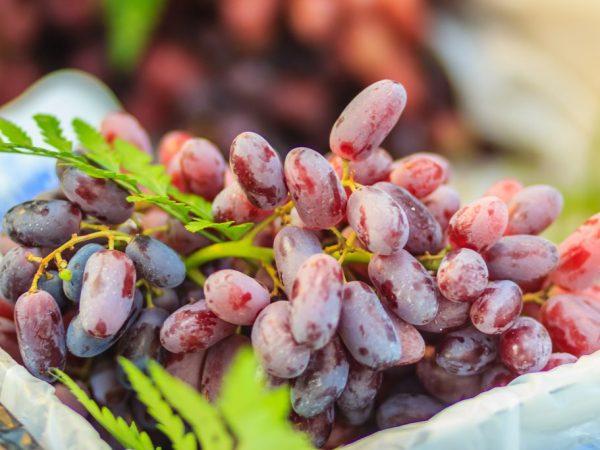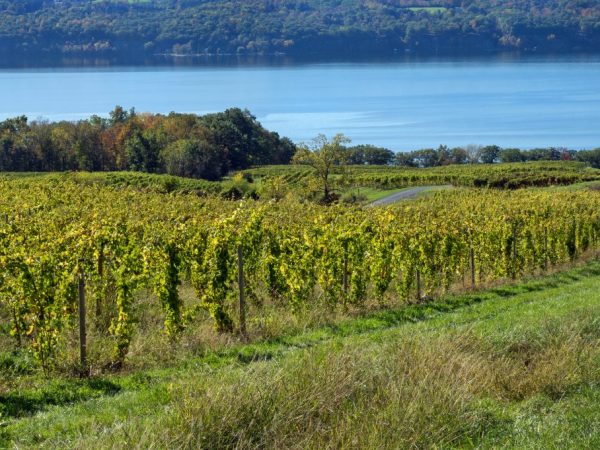Description of Taldun grapes
Among hybrid varieties, Taldun grapes stand out for their frost resistance and early ripening. The culture quickly takes root in the plots and gives a good harvest in the second year after planting.

Description of Taldun grapes
Characteristics of the variety
The Taldun grape is a hybrid of the Talisman and Dunav varieties. According to the description, the culture has the following features:
- Ripening period - 100-110 days. The species is classified as early maturing.
- The yield of the variety is 130-140 c / ha.
- The culture is frost-resistant and can withstand up to -22 ° C.
Suitable for the preparation of dessert wines, in cooking and for consumption. The culture is grown mainly in the middle lane.
Description of fruits
Shoots are medium-branched, with accelerated growth. The variety is self-pollinated, flowers are bisexual.
The foliage is large, with pronounced cuts. The cuttings have a closed notch.
The shape of the grapes is elongated. The weight of one berry reaches 18 grams. The color is dark red with a waxy coating. The pulp has a dense structure. Due to the hybrid origin, the berries do not crack when ripe. Fruits contain a large amount of sugar - up to 26%.
Culture care
Loamy or sandy loam soil with a low acidity level is suitable for planting. If the soil is too light, it is weighted with clay to increase the water holding capacity. Ash and sand are used to reduce acidity.
Watering varieties
Taldun grape is a moisture-loving culture. However, excess water will lead to the development of fungal diseases and foliage growth. There are two types of irrigation:
- Watering over the leaves. It is carried out during the dry season to protect foliage from burns.
- Watering at the root. Regular treatment for the complex development of the plant.
The first irrigation of the bushes is carried out after planting in the spring. Water for irrigation should be warm, up to 40 ° C. This will speed up the formation of the kidneys. Before planting the cuttings, the pit is poured with a bucket of water to warm up the soil. After planting the shoot, irrigation is carried out again by adding potassium and nitrogen to the water.
In the first month after planting, irrigation is carried out every week, in the evening. In the second month, the grapes are watered every 2 weeks.
Before the beginning of fruiting, the culture is not watered. This will increase the sugar content of the fruit.
During the preparation of the vineyard for winter, intensified watering is carried out between the rows. Magnesium and potassium are added to the water for irrigation.
Fertilizing crops

Top dressing will increase the productivity of plants
Lack of nutrients in the soil will reduce the yield of grapes and slow down the development of the vine. Among the one-component dressings, the following mineral fertilizers are suitable:
- potassium chloride;
- superphosphate;
- ammonium nitrate.
The solution is prepared based on the fertilization rate for one vine. Per bucket of water: 20 gr. superphosphate, 5 gr. potassium salt and 10 gr. saltpeter. Top dressing is applied three times:
- before flowering;
- after the formation of leaves;
- before the formation of ovaries.
Among fertilizers, complex fertilizing is also popular:
- Florovit;
- Aquarin;
- Novofert.
The soil can also be fertilized with organic fertilizing.Most often, manure is used for this purpose. For 1 m², 1 kg of manure is bred in a bucket of water. Organic fertilizers saturate the soil with oxygen and increase moisture permeability.
When using top dressing of animal origin, the risk of infection of the crop by pests increases. Manure attracts bear and drone to the site.
Vine formation
The grapes are characterized by high-speed formation of shoots. Without regular pruning, the intertwined vines will not get enough sun and the crop will die. The procedure is carried out using a sharp garden pruner. Cutting points are treated with charcoal or activated carbon.
The first pruning is done after planting. Among the shoots, the strongest is left, cutting off the weaker branches. By autumn, the top edge of the vine is removed.
In the second year, the formation of grapes is carried out in the fall in two stages. After collecting the bunches, cut off excess foliage, fattening shoots and dried parts of the vine.
The second pruning is carried out after all the foliage has fallen off. The temperature must be at least 3 ° C. Cut off shoots that do not bear fruit for the second or third year.
Pests and diseases
The Taldun variety, due to its hybrid origin, is immune to the main diseases characteristic of grapes. However, if not properly cared for, the crop can weaken and infest the vine.
Diseases of culture
There are several common diseases:
- Anthracnose. This fungal disease affects the leaves, shoots and fruits of the culture with brown spots. As a treatment, drugs Antrakol and Kuprosat are used.
- Mildew. A symptom of the disease is a powdery coating on the leaves of the plant. The disease is fought with the Bordeaux mixture.
- Gray rot. In the presence of the disease, the bunches become covered with a gray bloom and begin to rot. The disease is treated with Thanos and Strobi drugs.
Pests
The following harmful insects can harm crops:
- Cicadas. Insects feed on the sap of leaves and fruits. To combat them, the drug Aktara is used.
- Grape leaf roll. The pest feeds on buds, leaves and berries. To destroy the leaf roll, use the drug Vertimek.
- Wasps. The insect destroys the fruits of the culture. As protection from the pest, the plant is treated with Bi-58 insecticide.
Conclusion
Taldun grape is a balanced variety with good yield and resistance to adverse conditions. The fruits of the culture have high taste and are suitable for both food and wine making.


